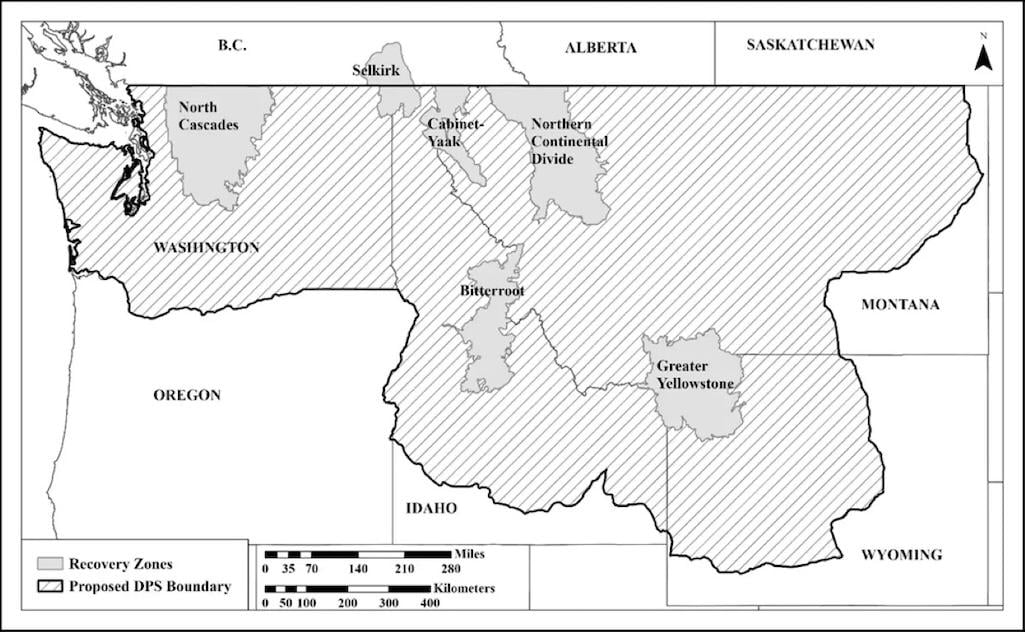
Grizzly bears will retain their "threatened" status under the Endangered Species Act, the U.S. Fish and Wildlife Service said Wednesday/NPS file
Grizzly bears in the Greater Yellowstone Ecosystem and the Northern Continental Divide Ecosystem will not lose their protections under the Endangered Species Act, the U.S. Fish and Wildlife Service announced Wednesday, though the agency also proposed to clarify exactly where the bears enjoy those protections.
“This reclassification [of recovery zones] will facilitate recovery of grizzly bears and provide a stronger foundation for eventual delisting,” said Fish and Wildlife Service Director Martha Williams. “And the proposed changes to our 4(d) rule will provide management agencies and landowners more tools and flexibility to deal with human/bear conflicts, an essential part of grizzly bear recovery.”
A federal judge in December had given the agency until January 20 to decide whether grizzlies in the ecosystem should retain their "threatened" status under the ESA.
USFWS was supposed to issue its decision last July, but instead set a self-imposed deadline of January 31, 2025. The agency was two years behind the original target date to announce its findings. Wyoming officials, eager to take over management of the grizzly population of the GYE within their state, were willing to wait no longer and sued the federal government in 2023 to force a decision. U.S. District Judge Alan Johnson in early December gave the USFWS the January 20 deadline.
In its decision Wednesday, the Service said grizzly populations in the two ecosystems still need ESA protections to recover. At the same time, the agency proposed to create a single "distinct population segment (DPS)" area, the smallest area where a species is protected under the ESA, that encompasses bear populations in those two ecosystems along with those in the North Cascades, Cabinet-Yaak, Selkirk, and Bitterroot ecoystems.

The U.S. Fish and Wildlife Service is proposing to draw a "distinct population segment" boundary for grizzly bears in the coterminous United States/USFWS
"Grizzly bear populations are now geographically closer to each other than ever, and the Service has documented grizzly bear movement between some populations, indicating recovery zones are no longer discrete," the Service said in a release. "This increased movement of grizzly bears illustrates the success of conservation and management efforts to date while highlighting the importance of establishing and maintaining conservation measures and management practices that foster continued movement of bears.
"Establishing a single DPS encompassing all six recovery zones will provide a comprehensive and scientifically based framework for recovery. Grizzly bear distribution has significantly expanded, largely due to the commitments of state, federal, and tribal agencies. These partners have played a key role in the on-the-ground management of grizzly bears for over 40 years by dedicating significant resources toward monitoring and management; in addition, private landowners have made sacrifices to accommodate grizzly bear."
The decision not to delist grizzlies was applauded by conservation groups that had pressed for continued listing.
“I’m relieved that the Fish and Wildlife Service followed the science and determined that grizzly bears still need Endangered Species Act protections,” said Andrea Zaccardi, carnivore conservation program legal director at the Center for Biological Diversity. “With ongoing federal protections, grizzlies in the Northern Rocky Mountains and North Cascades will have a real chance at long-term recovery, instead of being gunned down and mounted on trophy walls.”
“The NCDE and GYE grizzly bear populations have both come a long way since their listing in 1975, but both have farther to go," added Mike Senatore, senior vice president of Conservation Programs for Defenders of Wildlife. "Defenders is pleased that this species remains listed under the ESA, and that USFWS is cognizant of the work that still needs to be done to ensure resilient, connected grizzly bear populations into the future. As with all decisions of this nature, however, the devils are in the details, and we look forward to examining them closely.”
At the National Parks Conservation Association, Allison Michalski, Northern Rockies Connectivity Program manager, said the decision was sound.
“Thanks to years of hard work by state, federal and tribal wildlife managers, in partnership with farmers, ranchers, and local communities, grizzly bear populations have recovered from the brink of extinction," she said. "However, with threats remaining, including a lack of genetic connectivity between Glacier, Grand Teton, and Yellowstone grizzlies and problematic state laws and policies in Montana, Idaho and Wyoming, we still do not have a clear path to recovery. Bears, people, national parks, and our region’s unique working lands all benefit when we work together.”
Under the proposed 4(d) rule change, grizzly bears could be killed in more situations than under current regulations. For example, property owners would be allowed to kill bears actively attacking livestock.
“While grizzlies won’t be killed by state-sponsored trophy hunts, I’m concerned that their recovery will be harmed as more bears die at the hands of the livestock industry,” said Zaccardi. “We’ll advocate to maintain all protections that keep grizzly bears alive until recovery is reached."
One of the keys to the species' recovery is avoiding pockets of bears that could encounter genetic problems. While the USFWS has documented some movement by bears between ecosystems, Zaccardi said wildlife agencies "should focus on improving connectivity between regions and growing the small grizzly bear populations in the Bitterroots, Cabinet-Yaak and Selkirks. We know the states can’t be trusted to manage grizzly bears, and ongoing federal protections will keep grizzlies on the path to recovery.”




 Support Essential Coverage of Essential Places
Support Essential Coverage of Essential Places






